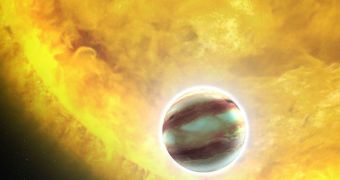At the recent National Astronomy Meeting, held in Manchester, the UK, two teams of researchers presented the progress they made in adapting models used to understand climate and weather on our planet to other worlds.
The scientists are trying to develop a series of tools that would enable them to study the atmospheres surrounding interesting extrasolar planets remotely. As the search for Earth-like planets is advancing, the necessity for such analysis instruments is becoming more and more apparent.
In addition, these adapted models could be used to gain a deeper understanding of how the Sun influences our planet, a phenomenon called space weather. The simulations currently being modified were originally developed by the United Kingdom Met Office.
Experts here are currently working together with the UK space weather research community to develop a “Unified Model” of Earth's atmosphere, including the thermosphere. The latter is a layer spanning from 90 to 600 kilometers (56 to 372 miles) above the surface.
The reason why the thermosphere is of so much interest to investigators is that space weather causes its most significant impact on this layer of the atmosphere. The layers underneath are largely spared.
“Space weather can affect the aviation and power industries, as well as a whole range of activities that rely on GPS timing and positioning, radio communication or satellite-based observations,” Met Office expert Dr. David Jackson explains.
“To develop a more accurate and useful advanced-warning system for space weather, we need to develop a system of interconnected models that describe the whole domain – the conditions on the Sun, interplanetary space, the layers of the Earth’s atmosphere, all the way down to the Earth’s surface,” he adds.
“The more accurate we can be in representing interactions between the lower atmosphere and thermosphere, the more we can enhance thermospheric forecasts, and thus improve space weather forecast products for users,” the scientist goes on to say, quoted by Astrobiology Magazine.
These data could also be useful for analyzing similar occurrences around other worlds. As the next generation of planet-hunting telescopes is being prepared for launch, experts also need to create a solid theoretical foundation on which advanced studies can be conducted.

 14 DAY TRIAL //
14 DAY TRIAL //